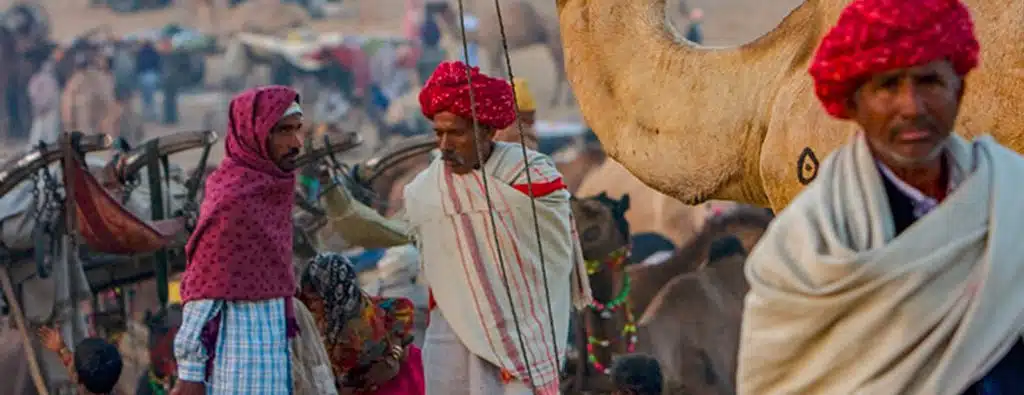The colorful and vibrant festivals of India have the dramatic effect of allowing travelers to gain a better perspective of one’s own identity by deeply discovering and experiencing another culture.
Far from superficial, the festivals of India revolve around celebrations of life itself, harvest times, seasonal changes, anniversaries of deities, and mythological stories as old as the Indus Valley. One of the vital birthplaces of civilization, India has since its inception been a destination for settlers and traders, a cultural cauldron from which has emerged a bounty of world religion and spirituality—not to mention arts and science.
A key to appreciating the richness of India’s festivals is that Hindus worship an array of thousands of gods and goddesses, while Buddha refused the existence of God itself. Yet here in this vibrant subcontinent both faiths are practiced and celebrated wholeheartedly—as is Islam, Sikhism, Christianity, Jainism, Zoroastrianism, Judaism, and the Baháʼí Faith.
The spontaneity and gaiety are infectious as festivals manifest through music, dance, colorful pageantry, and food. You begin to appreciate the plurality of India as you multiply this by each of the tribes of India, which will have unique celebrations and ceremonies, including distinct wardrobe or adornment, and host certain festivities according to individual calendars. As such there is no singular New Year holiday for the country. Rather it is celebrated on many different days.
The following are a few celebrations picked by our staff as their favorite “must experience” Indian festivals.
Holi
A richly photogenic festival, Holi sees people dousing each other in a heaps of colored powders and is probably one of India’s most beloved festival. Traditionally, Holi heralded the arrival of spring, fertility of the land and a good harvest. Today, Holi is an excuse for Indians to bring out the child in them, have a water-fight, throwing brightly colored powder (gulal) and water over each other. “Holi Hai” is the cry you hear as children, friends and neighbors gather on the streets and a riot of color takes over. Gulal is thrown into the air and smeared on faces and bodies. “Pichkaris” (water pistols) are filled with colored water and squirted on people. Water balloons are thrown at friends and neighbors in the spirit of fun. Celebrated in many regions and communities across Northern India, the Holi celebration falls on the full moon of the Hindu month of Phalguna, most often in March.

Pushkar Camel Fair
Rajasthan is equally famous for its fairs and festivals as its majestic Mughal forts and palaces. As many as a quarter million camels and livestock converge in the Rajasthan town of Pushkar at the edge of the Thar Desert for a camel fair that celebrates this timeless way of life. The camels are ornately decorated—dressed with mirror work embroidery, macramé murals and flower garlands—and paraded, competing in beauty contests, and raced. Festivities include music and performances, while the local herders who come to trade enjoy the occasion to catch up and do business in the stellar setting.

Nagaur Festival
Every year the Nagaur Festival draws scores of locals and tourists to Rajasthan’s town of Nagaur in the heart of the Thar Desert. Notably they come to watch tens of thousands of livestock—horses, cows, bullocks, oxen and camels—gathered for trade. The cattle fair is celebrated with fervor, and features folk music and dance performances, as well as camel and bullock races, and cockfights.

Ganesh
This 10-day festival marks the birth of the elephant-headed deity Ganesh, god of prosperity and wisdom. Taking place in the western state of Maharashtra, the grand scale of the festival owes to it being one of the most popular public events, and to its being celebrated since the days of King Shivaji who held put against the dominance of the Mughal Empire. During the time of British rule, the celebration transformed from private ceremonies to the public festivities we see today, in order to foster unity among all sections of Indian society. At the festival outset, enormous idols of Ganesh are raised atop a platform, and on the 10th day processions carry the idols to the river or the sea for submersion, symbolizing the deity’s journey home to the Himalaya.

Diwali
The five-day festival Diwali or Deepavali is celebrated by Indians of every faith throughout the country and the Indian diaspora across the world. One of the most joyous events, this “festival of lights” represents the celebration of the victory by the forces of Rama, the triumph of good over evil. Deepavali means “rows of lights and lamps,” referring to the lights and lamps lit in rows decorating homes and streets to light the way for Lord Rama returning home after 14 years in exile. The tradition of lighting lamps symbolizes the victory of freedom from darkness. This celebration most resembles the western festivities around Christmas time—gift exchanges, getting one’s houses in tip top shape, new clothes, toys, plenty of sweets, parties, friendly gambling, and lots of fireworks.
Krishna Janmashtami
Also known as Govinda, Krishna Janmashtami celebrates the birthday of Lord Krishna. Considered the most powerful and multidimensional incarnation of Lord Vishnu, he is believed to have been born in prison in 3228 BC and raised by foster parents. The celebration differs throughout India, each region having its own unique way of marking the occasion, each vibrant and passionately intense. Perhaps the most recognizable occasion among the festival involves teams of men climbing atop one another to form human pyramids in order to break open clay pots filled with churned butter (Krishna’s favorite food), hung from high buildings.
Onam
The largest festival of India’s southern state of Kerala, Onam is a harvest festival honoring the much beloved King Mahabali, who is believed to return to Kerala during the festival. According to Hindu mythology, King Mahabali defeated the Gods and began ruling over all three worlds. People decorate their homes with flowers arranged in intricate patterns to welcome the returning king. Celebrations include feasts served on banana leaves, folk dances, games, and snake boat races.

